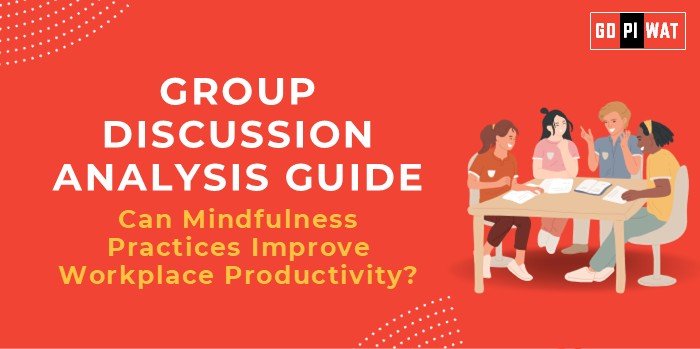📋 Group Discussion (GD) Analysis Guide: Can Mindfulness Practices Improve Workplace Productivity?
🌐 Introduction to the Topic
💡 Mindfulness in the workplace has become a focal point for modern organizational strategies aimed at enhancing productivity, employee well-being, and overall workplace culture. Rooted in ancient meditative traditions and bolstered by contemporary psychological research, mindfulness has transitioned from a personal wellness tool to a corporate necessity.
📊 Quick Facts and Key Statistics
- 📈 Global Market for Mindfulness Programs: Valued at $1.1 billion in 2023, with an expected CAGR of 10.2% (2024-2030).
- 🧘 Workplace Stress Levels: 83% of employees in the U.S. report work-related stress (APA, 2023).
- 📈 Productivity Boost: Companies that implement mindfulness programs report a 12% average increase in productivity.
- 💰 Mental Health ROI: Every $1 invested in employee mental health yields $4 in improved productivity (WHO, 2022).
👥 Stakeholders and Their Roles
- 🧑💼 Employees: Implement mindfulness to enhance focus, reduce stress, and improve interpersonal skills.
- 🏢 Employers: Invest in mindfulness training programs to boost productivity and reduce absenteeism.
- 🩺 Healthcare Providers: Design and facilitate mindfulness programs tailored to workplace settings.
- 📚 Academics and Researchers: Provide evidence-based insights into the impact of mindfulness on organizational outcomes.
🏆 Achievements and Challenges
✨ Achievements
- 🧠 Enhanced Focus: Studies show mindfulness increases attention spans by 15-20%.
- 🔥 Reduced Burnout: Mindfulness programs cut burnout rates by 25-30%.
- 🧩 Better Decision-Making: Companies report improvements in strategic thinking post mindfulness training.
⚠️ Challenges
- ❓ Skepticism: Many employees view mindfulness as a fad without concrete results.
- 🌐 Cultural Barriers: Variability in acceptance across different corporate cultures.
- 📊 Measuring ROI: Difficulties in quantifying the direct impact of mindfulness on productivity.
🌍 Global Comparisons
- 📖 Google’s “Search Inside Yourself” Program: Demonstrated measurable improvements in employee emotional intelligence and productivity.
- 🇯🇵 Japan: Leading mindfulness adoption, with 65% of companies offering meditation programs.
💬 Structured Arguments for Discussion
- 💪 Supporting Stance: “Mindfulness directly reduces workplace stress, leading to healthier and more productive employees.”
- ⚖️ Opposing Stance: “Mindfulness programs are costly and lack measurable impact, especially in high-pressure industries.”
- 🤝 Balanced Perspective: “While mindfulness offers clear benefits, its effectiveness depends on organizational culture and employee buy-in.”
📚 Effective Discussion Approaches
- 💡 Opening Techniques:
- 📊 “Statistics show that 83% of employees experience stress at work; could mindfulness be the solution?”
- 📚 “Google’s mindfulness program improved employee focus by 20%—is it time for global adoption?”
- 🤔 Counter-Argument Handling: Use evidence like WHO’s mental health ROI study to validate effectiveness. Address concerns with case studies such as Google’s program.
🔎 Strategic Analysis of Strengths and Weaknesses
- 💪 Strengths: Stress reduction, improved focus, and decision-making skills.
- 🛑 Weaknesses: Cultural resistance, skepticism, and scalability challenges.
- 🌟 Opportunities: Integration with wellness initiatives and digital mindfulness tools.
- ⚠️ Threats: Misinterpretation as pseudoscience and lack of sustained interest.
🎓 Connecting with B-School Applications
- 📊 Real-World Applications: Explore mindfulness impacts on organizational behavior, change management, and leadership development.
- ❓ Sample Interview Questions:
- 💡 “How can mindfulness practices support leadership skills?”
- 📚 “What are the measurable outcomes of mindfulness programs in the workplace?”
- 📝 Insights for Students: Mindfulness is a case study in organizational change management, offering insights into employee engagement strategies.


